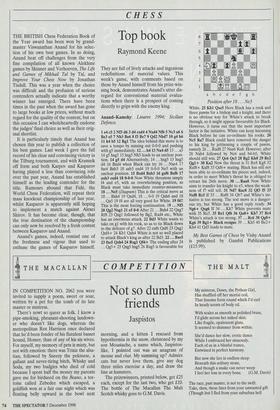CHESS
Top book
Raymond Keene
THE BRITISH Chess Federation Book of the Year award has been won by grand- master Viswanathan Anand for his selec- tion of his own best games. In so doing, Anand beat off challenges from the very fine compilation of all known Alekhine games by Skinner and Verhoeven, The Life and Games of Mikhail Tal by Tal, and Improve Your Chess Now by Jonathan Tisdall. This was a year when the choice was difficult and the profusion of serious contenders actually indicate that a worthy winner has emerged. There have been times in the past when the award has gone to large books at low prices, without much regard for the quality of the content, but on this occasion I can wholeheartedly endorse the judges' final choice as well as their orig- inal shortlist.
It is particularly timely that Anand has chosen this year to publish a collection of his best games. Last week I gave the full record of his clear and convincing victory in the Tilburg tournament, and with Kramnik off form and both Karpov and Kasparov having played a less than convincing role over the past year, Anand has established himself as the leading contender for the title. Rumours abound that Fide, the World Chess Federation, will repeat their mass knockout championship of last year, whilst Kasparov is apparently still hoping to implement a match against Alexei Shirov. It has become clear, though, that the true destination of the championship can only now be resolved by a fresh contest between Kasparov and Anand.
Anand's games, indeed, remind one of the freshness and vigour that used to enthuse the games of Kasparov himself. They are full of lively attacks and ingenious redefinitions of material values. This week's game, with comments based on those by Anand himself from his prize-win- ning book, demonstrates Anand's utter dis- regard for conventional material evalua- tions when there is a prospect of coming directly to grips with the enemy king.
Anand—Kamsky: Linares 1994; Sicilian Defence.
1 e4 c5 2 Nf3 d6 3 d4 cxd4 4 Nxd4 Nf6 5 Nc3 a6 6 Be3 e5 7 Nb3 Be6 8 f3 Be7 9 Qd2 Nbd7 10 g4 h6 11 h4 b5 12 Rgl The idea behind this move is to save a tempo by missing out 0-0-0 and pushing with g5 immediately. 12 ...b4 13 Na4 d5 13 ... a5 14 g5 hxg5 15 hxg5 Nh5 leads to an unclear posi- tion. 14 g5 d4 Alternatively, 14 ... hxg5 15 hxg5 d4 16 Bxd4 when Black can try 16 ... Nxe4 17 fxe4 Bxb3 18 axb3 exd4 19 0-0-0 Ne5 with an unclear position. 15 Bxd4 Bxb3 16 gxf6 Bxf6 17 axb3 exd4 18 0-0-0 Now White threatens simply f4 and e5, with an overwhelming position, so Black must take immediate counter-measures. 18 ...Ne5 (Diagram) This is the critical move as 18 ... Bxh4 19 Qxd4, 18 ... 0-0 19 Qxh6 and 18 Qa5 19 f4 are all very good for White. 19 f4!! This is the most forcing continuation. 19 ...N13 20 Qg2 Nxgl 21 e5 0-0 After 21 ... Bxh4 22 Qxg7 Rf8 23 Qxgl followed by Bg2, Rxd4 etc., White has an enormous attack. 22 Bd3 White wants to take on gl with his rook, so as to tie Black down to the defence of g7. After 22 exf6 Qxf6 23 Qxgl Qxf4+ 24 Kbl Qxh4 White is not so well placed to attack Black's king as after 22 Bd3. 22 ...Bxe5 23 fxe5 Qxh4 24 Rxgl Qf4+ The ending after 24
Qg5+ 25 Qxg5 hxg5 26 Rxg5 is favourable for a hcde f gh Position after 18 . . . Ne5
White. 25 Kbl Qxe5 Here Black has a rook and three pawns for a bishop and a knight, and there is no obvious way for White's attack to break through, so it might appear favourable for Black. However, it turns out that the most important factor is the initiative. White can keep harassing Black before he can co-ordinate his rooks. 26 Nc5 Raj Black could have removed the danger to his king by jettisoning a couple of pawns, namely 26 Rad8 27 Nxa6 Ra8. However, after 28 Nxb4 followed by Nc6 and b4-b5, White should still win. 27 Qc6 Qe3 28 Rg2 Kh8 29 Re2 Qgl+ 30 Ka2 Now the threat is 31 Re8 Kg8 32 Rxf8+ Kxf8 33 Qd6+ mating. Black has still not been able to co-ordinate his pieces and, indeed, in order to meet White's threat he is obliged to retract his 26th move. 30 ... Raa8 Now White aims to transfer his knight to e5, when the weak- ness of f7 will tell. 31 Nd7 Rac8 32 Qf3 f5 33 NxfB Rc5 If 33 ... Rxf8 34 Qb7 and White's ini- tiative is too strong. The text move is a danger- ous try, but White has a good reply ready. 34 Ng6+ Qxg6 If 34 ...Kh7 White prevents mate with 35 Re5. 35 Rel Qf6 36 Qa8+ Kh7 37 Bc4 White's attack is too strong. 37 ...Rc6 38 Qg8+ Kg6 39 Rgl + Black resigns 39 ... Kh5 40 Be2+ Kh4 41 Qd5 leads to mate.
My Best Games of Chess by Vishy Anand is published by Gambit Publications (£15.99).


















































































 Previous page
Previous page